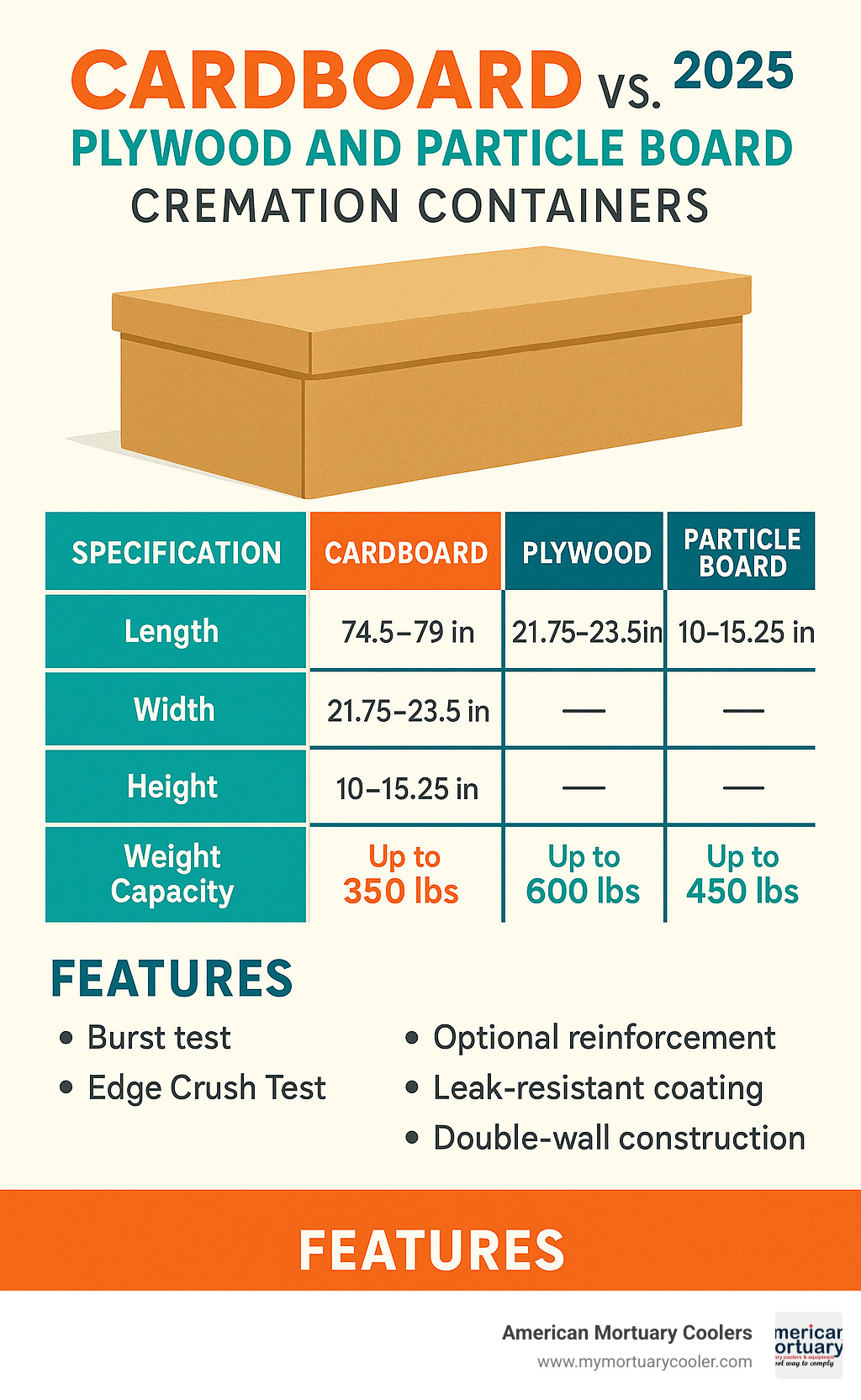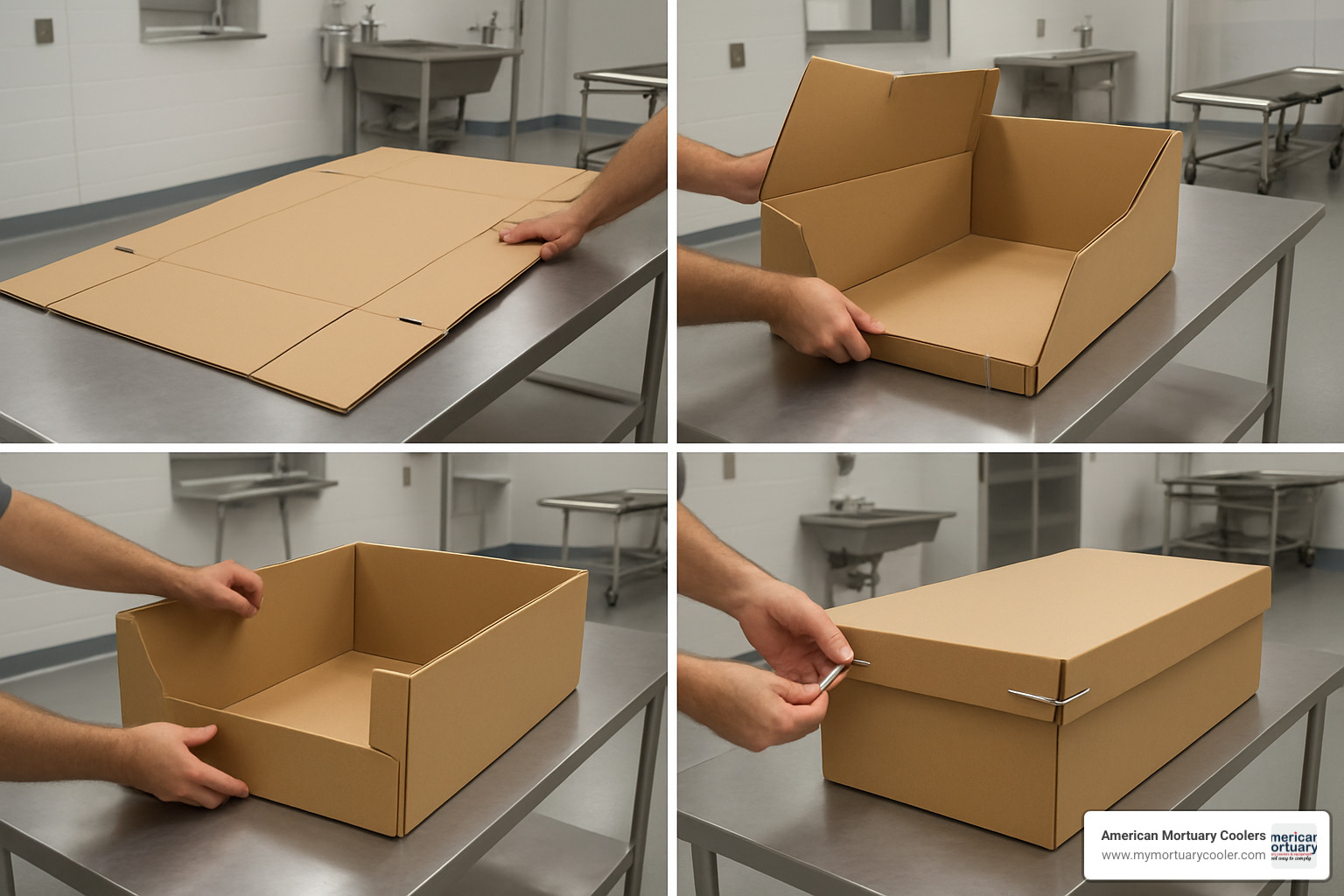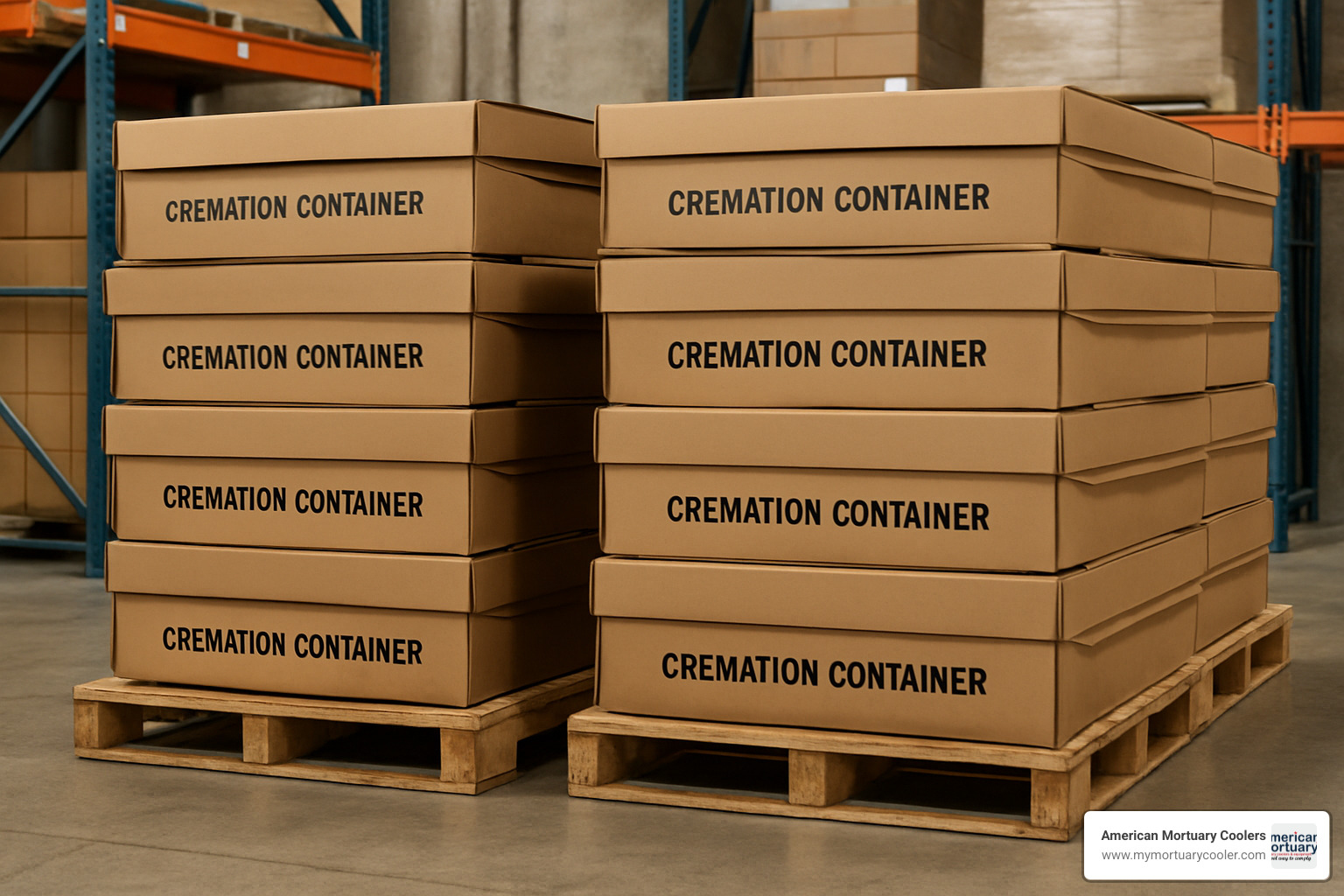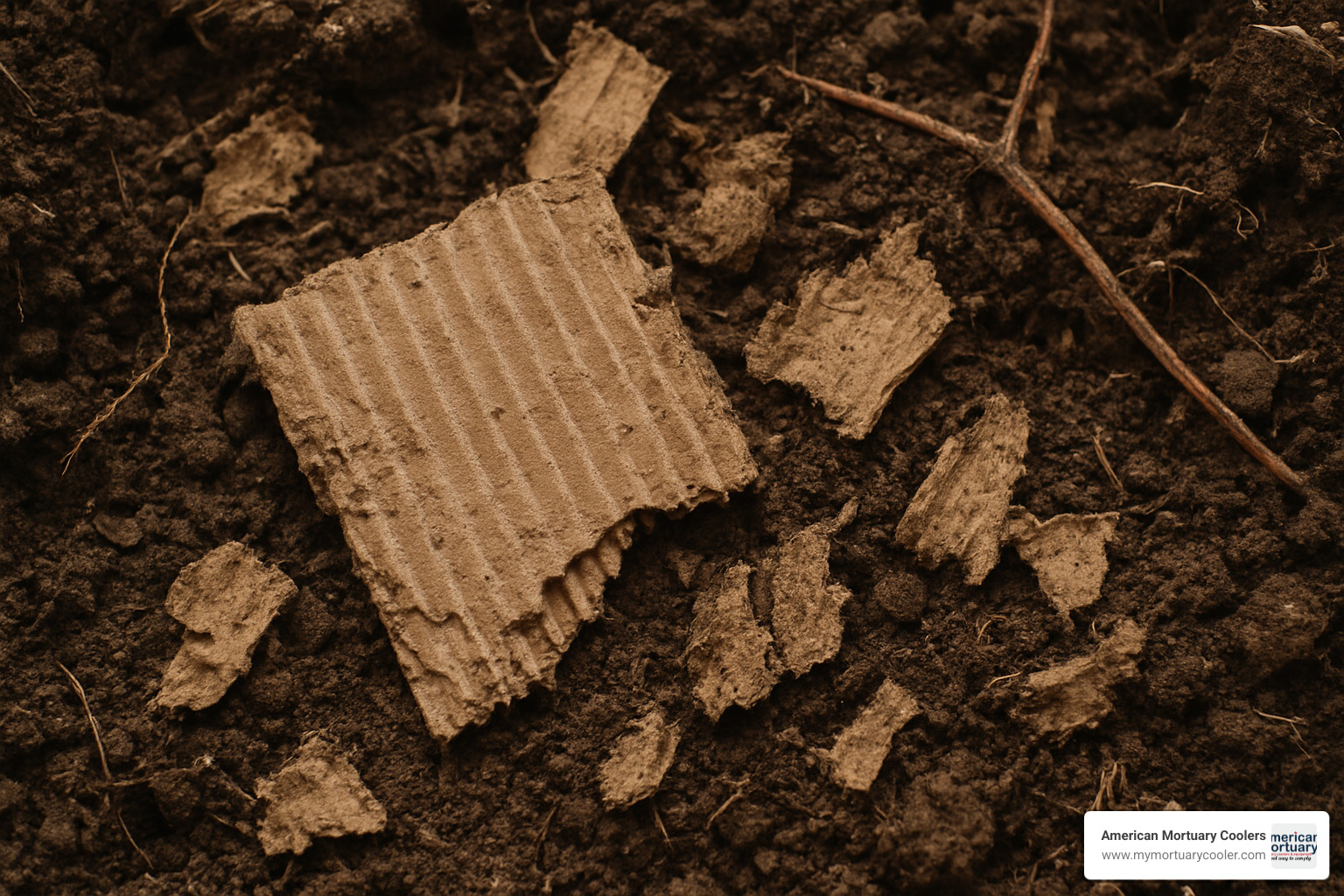Why Cardboard Cremation Containers Are Becoming the Industry Standard
Cardboard cremation containers are rigid, corrugated cardboard boxes designed to hold human remains during the cremation process. They serve as an affordable, eco-friendly alternative to traditional wooden caskets for direct cremation services.
Key Facts About Cardboard Cremation Containers:
- Price Range: $12.90 to $495.00 USD depending on construction and features
- Standard Dimensions: 74.5-79" long × 21.75-23.5" wide × 10-15.25" high
- Weight Capacity: Supports up to 200-350 lbs with proper construction
- Materials: Single-wall or double-wall corrugated cardboard with optional leak-resistant coating
- Assembly: Ships flat-packed, assembles quickly with zip-tie corners
- Legal Status: Meets rigid container requirements in most jurisdictions
The cremation rate in North America has grown dramatically over the past decade, driving demand for cost-effective container solutions. Many funeral homes now include cardboard containers at no additional cost in their basic direct cremation packages, making them accessible to families seeking simple, dignified options.
These containers aren't just about saving money. They're biodegradable, lightweight for handling, and ship efficiently in flat-pack form. The corrugated construction can be surprisingly strong - economy models support average-sized remains while premium versions feature double-wall construction and burst test ratings up to #750.
I'm Mortuary Cooler, a national-level mortuary cooler supplier with experience in funeral industry equipment and cardboard cremation containers. Through years of working with funeral homes across the country, I've seen how these containers have evolved from basic utility items to reliable, professional-grade solutions. Let me walk you through everything you need to know to make informed decisions for your facility.

What Are Cardboard Cremation Containers?
Think of cardboard cremation containers as the practical, no-nonsense solution that's revolutionizing how funeral homes handle direct cremation. These aren't flimsy boxes - they're engineered rigid alternative containers made from specially designed corrugated cardboard that can safely hold human remains throughout the cremation process.
The construction makes all the difference. You'll find two main types: single-wall and double-wall corrugated board. Single-wall containers work fine for lighter remains, but double-wall construction is where things get serious. These premium versions use double-wall kraft cardboard that's surprisingly robust.
How do we measure that strength? The industry relies on BT and ECT tests - technical terms that basically tell you how much weight and pressure these containers can handle. Burst Test (BT) ratings range from #350 for economy models up to #750 for heavy-duty versions. Edge Crush Test (ECT) ratings typically fall between 44-51 ECT, measuring how well the container resists crushing from above.
Many manufacturers add leak-resistant coatings to the interior - often Michelman coating - which creates a barrier against fluid leakage. Some models even include wood strips glued to the floor for extra structural support when handling heavier remains.
There's an important distinction between utilitarian and ceremonial use. Most cardboard cremation containers are purely functional - they're designed to transport remains safely and meet legal requirements. A few premium models can handle brief viewings, but they're not trying to replace traditional caskets for full funeral services.
History & Primary Uses of cardboard cremation containers
The story of cardboard cremation containers is really the story of changing funeral preferences. As more families chose direct cremation over traditional burial, funeral homes needed containers that met legal requirements without the cost of elaborate caskets.
Direct cremation became their primary calling. These containers go straight from the preparation room to the cremation retort, no ceremony required. They've also become essential for transport to retort - safely moving remains from preparation areas to cremation equipment without compromising dignity or safety.
Body storage is another key use. When remains need temporary storage in mortuary coolers before cremation, these containers provide secure, hygienic containment. Some specialized versions even handle mailer and ship-outs for transporting cremated remains to other locations.
The evolution has been remarkable. Early versions were basic utility boxes. Today's cardboard cremation containers feature engineered construction, standardized dimensions that fit cremation equipment perfectly, and professional-grade strength ratings that funeral directors can trust.
Legal Definition and Regional Terminology
Here's where it gets interesting - the legal landscape varies by location, but the core requirement stays consistent. Most jurisdictions require a "rigid container" for cremation, and cardboard cremation containers absolutely meet this standard.
British Columbia law spells it out clearly: "the deceased is enclosed in a rigid container for cremation." Similar requirements exist across North America, though the specific wording changes.
You'll hear different terms depending on where you are. Alternative container is the formal industry term used in most regulations. Minimum container often describes the most basic option that still meets legal requirements. Cremation tray gets used interchangeably sometimes, though trays are typically simpler, more basic designs.
The key thing to remember? Whether you call them alternative containers, minimum containers, or cremation trays, properly constructed cardboard cremation containers meet legal requirements while providing families with an affordable, dignified option for their loved ones.
Key Features & Technical Specifications
Standard cardboard cremation containers measure 74.5-79 inches in length, 21.75-23.5 inches in width, and 10-15.25 inches in height. These dimensions accommodate most adult remains while fitting standard cremation equipment.
Weight capacity varies significantly based on construction. Basic models handle up to 200 pounds, while reinforced versions support 350 pounds or more. The key specifications include:
- Burst Test ratings from #350 to #750, measuring pressure resistance
- Edge Crush Test ratings of 44-51 ECT for stacking strength
- Optional wood strips for floor reinforcement
- Michelman leak-resistant coating for fluid protection
- Double-wall kraft construction in premium models

Strength & Safety Standards for Cardboard Cremation Containers
Understanding the testing standards is crucial for selecting appropriate containers. The Burst Test (BT) measures the pounds of pressure required to burst the cardboard, indicating containment strength. A #350 BT rating means the cardboard can withstand 350 pounds per square inch of internal pressure.
The Edge Crush Test (ECT) measures top-to-bottom compression strength, crucial for stacking and handling. Higher ECT ratings indicate better durability when containers are stacked or subjected to vertical pressure.
ASTM D642 provides standardized testing procedures for corrugated containers, ensuring consistent quality across manufacturers. Leak protection comes from specialized interior coatings that create a moisture barrier, essential for maintaining dignity and safety during transport.
Four-corner zip-tie assembly has become the industry standard, providing secure closure while allowing quick assembly. This system is more reliable than adhesive-only closures and provides visual confirmation of proper assembly.
Assembly & Practical Handling of Cardboard Cremation Containers
One of the greatest advantages of cardboard cremation containers is their flat-pack shipping design. Containers arrive folded, dramatically reducing storage space and shipping costs compared to pre-assembled alternatives.
Assembly is straightforward:
- Unfold the flat-packed container
- Form the base by folding along pre-scored lines
- Secure corners with provided zip ties
- Ensure all edges are properly aligned
- Test stability before use

The containers are designed for lift compatibility, with reinforced areas where lifting equipment makes contact. This is crucial for safe handling in mortuary environments where mechanical lifts are standard equipment.
Oversize, Infant & Specialty Models
The industry recognizes that one size doesn't fit all. Specialized cardboard cremation containers include:
- Midsize models (like the 9-03) for smaller adults
- Infant containers starting at $4.94, designed for pediatric remains
- Oversize trays (9-02 model) for larger individuals
- Pet cremation options for veterinary cremation services
- Custom sizing available from some manufacturers
These specialized containers maintain the same construction principles as standard models but with appropriate dimensional adjustments and weight ratings.
Cost, Personalization & Where to Buy
When it comes to cardboard cremation containers, you'll find prices ranging from a modest $12.90 for basic economy models up to $495.00 for premium versions with all the bells and whistles. That's quite a spread, but it makes sense when you consider the differences in construction quality, materials, and special features.
The beauty of buying in bulk really shows here. Most suppliers offer volume discounts that can significantly reduce your per-unit costs. You'll typically see standard pricing for smaller orders of 1-49 units, but once you hit that 50-unit mark, discounts of 10-15% kick in. Order 100-199 containers and you're looking at 15-20% off, while orders of 200 or more can net you 20% or better savings.
Here's something that makes these containers even more accessible: many funeral homes include cardboard containers at no additional cost in their direct cremation packages. This approach removes financial barriers for families who are already dealing with loss and helps ensure everyone has access to dignified cremation services regardless of their budget.
The personalization options have really evolved beyond basic functionality. You can now add silk-screen logos to showcase your funeral home's branding, create photo wraps that display meaningful memorial imagery, or include custom printing for personal messages from the family. Some facilities even use rental inserts - these allow families to have a brief viewing in a more presentable container before transferring to the cremation container.
More info about choosing containers
Retail vs Wholesale Purchasing Channels
Cardboard cremation containers operate primarily in the professional marketplace. Most funeral homes purchase directly from manufacturers or work through established industry distributors who understand the specific needs of funeral service providers. While online suppliers have emerged in recent years, the vast majority require professional licensing before you can even see pricing.
Those professional-only portals aren't trying to be exclusive for the sake of it - they're maintaining industry standards by restricting access to licensed funeral directors, crematories, and related businesses. This ensures that containers are handled properly and integrated into comprehensive cremation services that require professional oversight.
Consumer access is intentionally limited. Families generally cannot purchase these containers directly and must work through funeral homes instead. While this might seem restrictive, it actually makes perfect sense from both regulatory and practical standpoints. Proper handling requires specific training, and these containers need to be part of a complete cremation process that demands professional supervision.
Shipping & Storage Considerations
The flat-pack design of these containers creates some real advantages when it comes to shipping and storage. Since containers arrive folded, they take up 80-90% less space than pre-assembled alternatives - that's a game-changer for both shipping costs and your storage room.
You'll commonly see two-pack bundles that provide additional cost savings, and standard pallet dimensions can accommodate 20-30 folded containers depending on their size and construction type. Just remember that dry indoor storage is absolutely essential. Cardboard and moisture don't play well together, and any exposure to dampness can compromise the structural integrity you're counting on.
Weight labeling becomes crucial for proper selection. Make sure your containers are clearly marked with their weight capacity ratings, and maintain good inventory tracking so you can select the right container for each situation. Nothing's worse than finding mid-process that you've chosen a container that won't safely handle the weight requirements.

Regulations, Environmental Impact & Green Practices
The legal landscape around cardboard cremation containers is surprisingly straightforward, though it varies by region. Most jurisdictions simply require what they call a "rigid container" for cremation - and cardboard fits the bill perfectly.
British Columbia takes a clear stance with their explicit rigid container rule, stating that deceased individuals must be enclosed in a rigid container for cremation. This regulation is typical across North America, where lawmakers focus on dignity and safety rather than mandating expensive materials.
In the United States, the FTC Funeral Rule takes a different approach. Rather than dictating what containers you must use, it requires funeral homes to disclose all available options to families. This means funeral directors must explain that cardboard cremation containers are a legal, viable choice - not just push families toward more expensive caskets.
Here's where things get interesting for environmentally conscious families. These containers are manufactured from biodegradable materials, typically using recycled content cardboard. The carbon footprint is dramatically lower than wood alternatives - no trees are cut down specifically for casket production, and the manufacturing process requires far less energy.
The environmental benefits extend beyond just the materials. Because they ship flat-packed, transportation emissions are reduced significantly. A truck that might carry 20 wooden caskets can transport hundreds of folded cardboard containers, making the entire supply chain more efficient.
For families choosing cremation specifically for environmental reasons, cardboard cremation containers align perfectly with those values. They burn cleanly during cremation and don't release the chemicals that can come from treated wood or metal hardware.
Even airline regulations have adapted to modern realities. The TSA and international aviation authorities now recognize properly constructed cardboard containers as acceptable for transporting cremated remains. This practical recognition shows how these containers have become mainstream across all aspects of funeral service.
Click Here to View Our Consumer Information Guide
Advantages & Disadvantages of Cardboard Cremation Containers
Let's be honest about what you're getting with cardboard cremation containers - and what you're not.
The cost advantage is undeniable. We're talking about containers that cost $12.90 to $495, compared to wooden caskets that can run thousands of dollars. For families dealing with unexpected loss, this price difference can be life-changing.
From an environmental perspective, cardboard containers are genuinely impressive. They're made from biodegradable materials that break down naturally, whether they're cremated or buried. The manufacturing process has a much smaller carbon footprint than traditional casket production.
Storage and handling benefits matter more than you might think. Funeral homes love that these containers arrive flat-packed, taking up minimal storage space. When it's time to use them, assembly is quick and straightforward with pre-scored folding lines and zip-tie corners. Staff find them much easier to maneuver than heavy wooden alternatives.
But let's talk about the trade-offs. Aesthetically, cardboard containers have a utilitarian appearance that may not suit families wanting a more traditional look. They're designed for function, not beauty, and that shows.
Weight capacity has real limitations. While premium models can handle 350 pounds, that's still lower than what wooden or metal alternatives can support. For larger individuals, you might need specialized oversize models or different solutions entirely.
Moisture sensitivity requires careful handling. These containers must be stored in dry conditions and handled properly to maintain their structural integrity. A wet storage area or careless handling can compromise the container's ability to do its job safely.
The single-use design means there's no option for reuse, unlike some traditional caskets that families might repurpose or pass down. Once used, that's it.
Fit With Green Burial & "No-Flame" Technologies
The funeral industry is evolving rapidly, and cardboard cremation containers are perfectly positioned for emerging green technologies and practices.
Alkaline hydrolysis, sometimes called water cremation or resomation, represents the cutting edge of body disposition. This process uses water, heat, and alkaline chemicals to accelerate natural decomposition. Specialized cardboard containers are being developed specifically for this technology - they dissolve safely during the process, leaving only the natural remains.
Natural cemetery burial is another growing trend where these containers shine. Unlike traditional caskets that can take decades to decompose, cardboard containers break down naturally in soil within months. They leave no permanent environmental impact, appealing to families seeking the most responsible options available.

Some forward-thinking cemeteries now specifically welcome cardboard cremation containers for green burial sections. These dedicated areas focus on minimal environmental impact, and cardboard containers fit perfectly with those values.
Resomation trays represent the most specialized application. These containers are engineered specifically for alkaline hydrolysis systems, designed to dissolve completely during the process. It's fascinating technology that's still emerging, but it shows how adaptable cardboard container design can be.
The beauty of this trend is that families don't have to choose between affordability and environmental responsibility. Cardboard cremation containers deliver both, making green practices accessible to everyone regardless of budget constraints.
Frequently Asked Questions about Cardboard Cremation Containers
I get these questions all the time from funeral directors who are new to cardboard cremation containers. Let me clear up the most common concerns with straightforward answers.
Are cardboard cremation containers required by law?
Here's the thing - cardboard cremation containers aren't specifically required by law, but they're often the practical solution to meet legal requirements. Most places require what's called a "rigid container" for cremation, and cardboard containers check that box perfectly.
British Columbia spells it out clearly: remains must be "enclosed in a rigid container for cremation." Other jurisdictions use similar language without getting specific about materials. The key word is rigid - and properly constructed cardboard containers absolutely meet this standard.
Many funeral homes choose cardboard containers because they satisfy legal requirements while keeping costs reasonable for families. It's a win-win situation that meets both regulatory needs and budget considerations.
Can they be used for a public viewing?
This is where expectations matter. Basic cardboard cremation containers are built for function, not beauty. They're utilitarian by design - think sturdy shipping box rather than neat casket. For most public viewings, they just don't have the dignified appearance families expect.
But here's where it gets interesting. Premium cardboard containers with cloth coverings or special finishes can work for brief, intimate viewings. Some funeral homes also use rental caskets for the viewing service, then transfer the deceased to a cardboard container afterward for cremation.
The rental approach gives families the ceremony they want while still using cost-effective containers for the actual cremation. It's become a popular middle-ground solution that honors both dignity and budget.
How do I ensure the container is strong enough for my loved one's weight?
Weight capacity is clearly marked on quality cardboard cremation containers - always check this first. Basic models typically handle up to 200 pounds, while reinforced versions support 350 pounds or more.
Look for the technical ratings too. Burst Test (BT) ratings of #350 or higher indicate good containment strength. Edge Crush Test (ECT) ratings of 44-51 show the container can handle stacking and vertical pressure without collapsing.
For heavier individuals, choose containers with wood strip reinforcement glued to the floor and double-wall construction. These features dramatically increase weight capacity and overall durability. When in doubt, go with the stronger option - it's better to have more capacity than you need than to risk structural failure during transport or handling.
The manufacturers have done the engineering work. Trust the ratings, choose appropriately, and you'll have reliable performance every time.
Conclusion
After working with funeral homes across the country for years, I've watched cardboard cremation containers transform from basic boxes into the reliable, professional-grade solutions they are today. What started as a simple cost-cutting measure has evolved into something much more meaningful - a way to serve families with dignity while respecting both their budgets and the environment.
The beauty of these containers lies in their simplicity and versatility. Whether you're serving a family who values environmental responsibility, managing tight budgets, or simply need a reliable container that gets the job done, cardboard cremation containers deliver. The key is understanding what you're working with - matching the right burst test ratings to weight requirements, choosing appropriate models for your specific needs, and knowing when premium features like leak-resistant coatings make the difference.
What I find most encouraging is how these containers support the broader shift toward more accessible, environmentally conscious funeral services. Families today want options that reflect their values, and cardboard cremation containers offer exactly that - a choice that's both practical and principled.
At American Mortuary Coolers, we've seen how the right equipment makes all the difference in daily operations. That's why we stock lift-compatible cardboard cremation containers that work seamlessly with mortuary cooler systems. Our nationwide delivery network reaches from our Tennessee headquarters to funeral homes across all 48 contiguous states - from busy urban centers like Atlanta and Chicago to smaller communities throughout the Midwest and beyond.
Whether you're in our Southeast Region, Pacific Region, or anywhere in between, we understand that every funeral home has unique needs shaped by their community and clientele. Our experience serving diverse markets has taught us that there's no one-size-fits-all solution, but there are reliable tools that consistently deliver professional results.
More info about cremation container options
The funeral industry will continue evolving, and cardboard cremation containers have proven they're not just a temporary trend - they're a permanent part of the toolkit for serving families with dignity, affordability, and environmental responsibility. Making informed choices about these essential containers helps ensure that every family receives the respectful service they deserve, regardless of their budget or preferences.
















